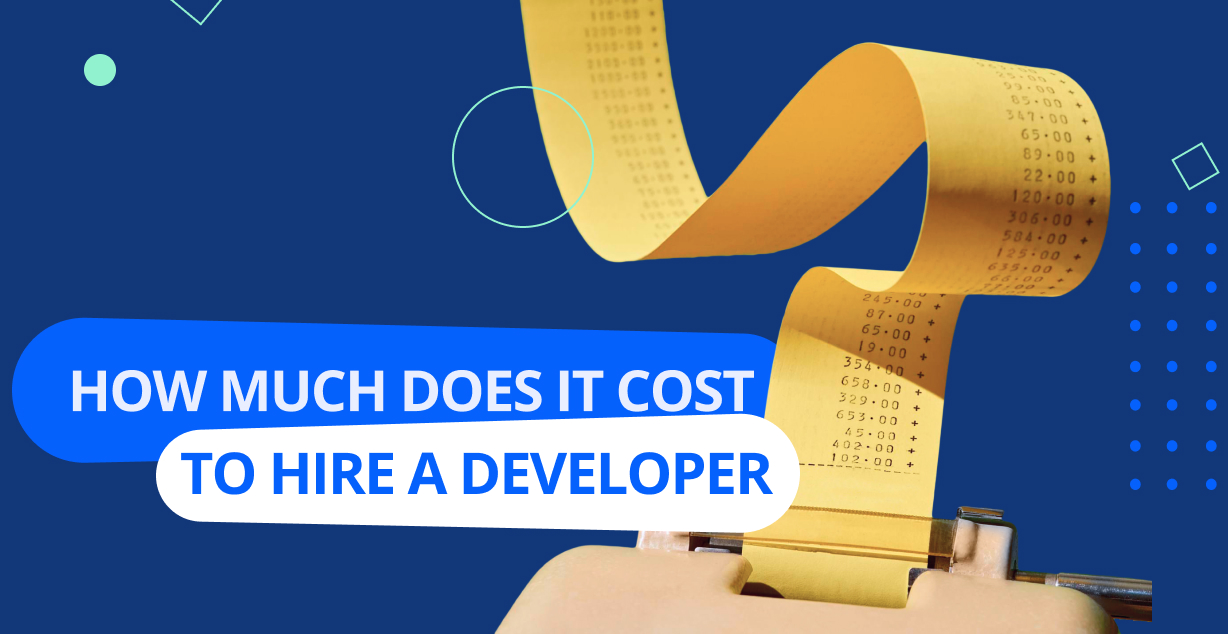Creating an app is similar to going out. We need not explain the difference between a “snack” at Subway and dinner at a Michelin star restaurant. It’s the same with software development: what you want to get determines how much you have to spend on it.
Some app development cost $10,000, while others cost $200,000. This article will try to explain what these prices depend on and how much it costs to develop an app.
- 1. App development cost calculator
- 2. What type of client you belong to
- 3. How cooperation model can influence the app cost
- 4. How functionality can influence the app cost
- 5. How platform type can influence the app cost
- 6. How technology stack can influence the app cost
- 7, How region can influence the app cost
- 8. How team size can influence the app cost
- 9. How to estimate your app
- Tips to help you reduce the app cost
App development cost calculator
The formula for calculating the cost of creating an app is:
APP DEVELOPMENT COST = TOTAL DEVELOPMENT TIME*HOURLY RATE
where Total Development Time – the time in hours spent developing the application
Hourly Rate – the hourly rate of the application developer
Both variables have the same impact on the final cost of creating an app. However, they depend on different factors.
| Total Development Time | Hourly Rate |
| Functionality | Cooperation Format |
| Platform Type | Developer Level |
| Technology | Technology |
| Developer Location |
This article will look closely at the factors that affect total development time and briefly discuss the hourly rate.

What kind of customer you are or “What would you like to start with”
Imagine you want to go out to eat at a restaurant. How much would that cost?
That depends on what you want: how many dishes you choose, whether you order wine, whether there will be dessert or not, the quality of the dishes, the atmosphere of the restaurant, and so on.
The better you know what you want, the more predictable your costs will be. This does not mean you will spend less than you would have without this knowledge. However, this way, you can plan your budget and get what you wanted.
When it comes to app development, everything works the same way. The first thing a developer will ask you is, “What kind of app do you want to build?”
Every client answers differently, but to summarise, we can distinguish these two types:
The first type – “I’ll have whatever he’s having”
You belong to this customer if you want to develop an application like the one you have seen from someone else. You don’t have enough technical knowledge, but you know precisely what business problem you want to solve. For example, to attract new visitors to your restaurant.
The second type – “I’m my own Gorden Ramsay”
You belong to this type of customer if you have the knowledge and experience to develop applications. When you go to a restaurant, you say, “I want a steak, make sure the steak is relaxed, meaning it’s at room temperature, flip the steak once during cooking, don’t forget a few sprigs of thyme”.
You know the answers to the questions:
- WHAT (video-streaming web app)
- FOR WHOM (teens ages 13 – 17)
- HOW (using react native technologies) you create
You have a solid business plan and the ability to manage the development team when needed.
The choice of cooperation models that directly affect your costs depends on what type of client you are.
App development cost by cooperation model or “Chef’s table”
There are usually four models of working with developers: employee, freelance, outsourcing, and outstaffing. Each model has its advantages, disadvantages, and risks.
VAT is necessary only if the contractor is in the same jurisdiction as the client
We will talk about the main issues related to costs. Also, choose a cooperation model that suits you.
Four models of cooperation:
Employee – you work with a specialist you have hired to join your team. Such specialists are usually more involved in the work process and more loyal to the company. However, hiring developers comes with additional costs, such as payroll taxes, benefits, and various types of insurance.
Freelancer – you work with a specialist, but he is self-employed. He is not a permanent employee of a company. The work is done under a contract. Freelancers usually work on short-term projects that are not critical projects of the company. They do not have to pay taxes and bonuses like a regular employee. However, if the freelancer is in the same jurisdiction as the client, they must pay VAT. However, in the short term, freelancing is considered the cheapest option.
Outsourcing – you work with a company that does the entire project. On the one hand, this is convenient because they have the team you need, and you don’t have to worry so much about oversight. But it can also be a disadvantage. Because if you don’t have the expertise, you become dependent on the contractor’s company. Therefore, the most important projects of the company are rarely outsourced. Also, you must pay VAT if the contractor is in the same jurisdiction as you. However, in the short term, this is still a profitable model of collaboration for specific projects.
Outstaffing – you work with a company that provides you with a specialist. Unlike outsourcing, you manage their work yourself. You continue to pay no additional costs other than VAT. This model has the advantage that you can manage the workload yourself and scale it up or down as needed. However, it can also be a disadvantage if you don’t want to spend a lot of time on monitoring.


What model is the best option for you
Now let’s determine which model suits you.
| Type of client | Employee | Freelance | Outsource | Outstaff |
| 1 | – | – | + | – |
| 2 | + | + | + | + |
Suppose you belong to the first type of client. In that case, you can choose only the outsourcing model because you do not have enough knowledge to control the developers and evaluate the quality of their work, which is necessary for other models of cooperation. To organize control over the implementation of requirements and build a system of evaluation, you’d better find a CTO who will manage technology within an organization and be the bearer of expertise. If you don’t have a CTO yet, you can discover how to hire one in our article How to hire CTO for Startup and Not to fail.
If you belong to the second type of client, you can choose any cooperation model, since you have enough knowledge to manage the developers’ work yourself. The dilemma in choosing a cooperation model boils down to one question: personal resources – your time or financial resources – your money.
To sum things up: more knowledge = more flexible you are.
App development cost by functionality or “Mise en place”
The cost of creating an app depends heavily on the features included. The bigger and more complex the features are, the more expensive the app is.
Let’s look at how features affect development time. Take a video streaming app as an example.
Features of video streaming app
Video-Streaming apps are a category of entertainment apps that allow users to watch movies, TV shows, listen to music, read the news, etc. Examples: Netflix, Hulu, Twitch, YouTube, HBO Go, etc. The most common features of such apps are described below (in order from “must-have” to “would like to have”).
| FEATURES | DESCRIPTION |
| ADMIN PANEL | App administrators can edit and delete videos, moderate content and users, and other back-office operations. |
| REGISTRATION | Log in via email or social media accounts. |
| USER PROFILE | Create a personal profile. Users can view their favorite videos and history, add new videos to the list, update their user information, and control billing. |
| CONTENT SEARCH | The search bar, the ability to find relevant content, filter content by genre, recommendations, release date, etc. The primary purpose is to make the search easy and fast for the end-user. |
| PAYMENT GATEWAY | Integrate with Braintree, Stripe, PayPal, Apple, Google Pay, etc. to allow users to pay for content or subscriptions. |
| LIVE STREAMING VIDEOS | Live stream TV programs, news, sports competitions, etc. |
| COMMENTS | Comment and discuss content. ( + moderation or anti-spam) |
| NOTIFICATIONS | Notify users of new content, updates, and payment information. |
| SETTINGS | Audio level selection, subtitle activation, play, and pause options. Things that allow users to interact with the platform. |
| MULTI-LANGUAGE SUPPORT | Select the language for video playback and enable subtitle localization. |
| SOCIAL MEDIA INTEGRATION | Post content – news, ads, reviews, etc. – on social networks. |
| VIDEO-SHARING | Users to share their favorite video or even just a link with their friends on various other platforms. |
| VIDEO QUALITY | Choose the preferred quality of video content. |
| DOWNLOAD FEATURE | Upload content to local device storage. |
| WATCH IT LATER | Download your favorite content and watch it later, even without an active internet connection. |
| CREATE A PLAYLIST | Select your favorite shows on TV and add them to your playlist. |
| REVIEWS AND RATINGS | Rate movies, TV shows, etc. |
| GEO-BLOCKING | Distributing certain content available on your platform may be prohibited in a particular country or region. |
| CHATBOT INTEGRATION | Support 24*7 in most areas.Intelligent AI-based chatbot solutions that help users with whatever they are looking for. |
| ADD FRIENDS | Add people by interest. |
| CHAT | Send private messages/group chats, transfer files, save/delete messages, emoticons/emojis, etc. |
The number of features you want to add to your application will determine the total development time and, therefore, the project’s cost.
Development strategy
“There is nothing so useless as doing efficiently that which should not be done at all” – said Peter Drucker, an economist and one of the most influential management and marketing theorists of the 20th century.
In 2010, The Standish Group an independent international consulting company that analyses IT projects’ effectiveness, conducted a study of 100 user applications. The study attempted to test the features that are most frequently requested, implemented, and used. According to the study results, only 20% of the functions are used frequently, 30% sometimes, and 50% rarely.
Thanks to this research, the concept of MVP has gained popularity. Its essence lies in the fact that, first, an application is developed with a minimal set of features. Then the idea is tested in the market. And if a project succeeds, additional features are added to the app.

MVP-Minimal Viable Product (minimum viable product) – a test version of a product with a minimal set of features that have value to the end-user.
We can conditionally distinguish three levels of application development:
- Simple (MVP) – the app contains a minimum set of features, most of which are basic or relatively easy to build (usually 1 platform).
- Medium app contains more features than a simple app. Or the features are multitasking (1-2 platforms).
- Complex is an app with many features, which provides a competitive advantage (3 or more platforms).
As you may have noticed, functionality is often considered simultaneously with the platforms (web, Android, iOS) on which the application will be implemented.
This is because the same functionality can be implemented differently on each platform. Therefore, the choice of the platform directly affects the final cost of creating an app.
App development cost by platform type or “Double sat”
There are usually three main types of applications, depending on the platform: web, native, hybrid. Each type requires different developer skills.
Web app – a website with interactive elements. Almost every Internet resource belongs to web applications. To interact with the application, you must have the Internet.
Popular Technologies: HTML/CSS, JavaScript, TypeScript, Ruby, PHP, etc.
Native app – a mobile application developed for a specific mobile platform ( iOS, Android, Windows). It is less dependent on the quality of the Internet than the web application.
Popular Technologies: Java, Kotlin, Swift, Objective-C, PHP, Python, C++, etc.
Hybrid app (cross-platform) – a mobile application developed in a universal language for multiple platforms simultaneously. It is less dependent on the quality of the Internet than web applications.
Popular Technologies: Ionic, Flutter, React Native, PhoneGap, Xamarin, etc.
How to choose the right platform
Choosing an app platform depends on several factors, including:
- Business requirements;
- Scaling and performance requirements;
- Intended functionality;
- Developer skills;
- Project deadlines, etc.
The most important thing to look for when choosing a platform is how the user will interact with your product. If the product does not change the user’s daily lifestyle, but only performs a specific function or is unstable in use, the choice often falls on a web application with a mobile responsive design—examples: CRM systems, online catalogs, sites where you can order something.
When the application changes the user’s habits, speed is important, and the choice falls on a mobile application—examples: Instagram, various messengers, fitness apps.
Native or Hybrid app
Native apps should be chosen if you want a unique design if the app is complex, and if the user interacts with the iOS and Android app in diverse ways.
If design is not the main concern and the functionality of the platforms is similar, the choice falls on hybrid apps.
If you doubt what type of app to choose for your project, we can help you choose the type of app.
Cost of creating an app by platform type
Depending on the app you choose, the development time varies, and so does the cost. A clear difference can be seen in the infographic below:
Our technical team performed the evaluation. The development time for each feature is approximate.
As you can see, the development time for a web app is the longest. In second place is the hybrid app. In third place are the native iOS and Android apps.
It’s worth noting that developing one hybrid app is much cheaper than developing two native apps for iOS and Android.
App development cost by technology stack or “Platting”
As we have seen, the application you are developing directly affects the technologies the developer should have. The more complex the functionality of the application and the more platforms for which the application is to be written, the larger the pool of technologies needed to implement the project. This pool of technologies is called the technology stack.
The technology stack combines software tools and programming languages used to build your web or mobile application.
You can see an example of a technology stack in the infographic for building a video streaming app.
Not all of the above technologies will be useful to you. The choice of a tech stack depends on many factors, the most important of which are: the scaling and performance requirements, the intended functionality of the application, and the human resources available in the labor market. If choosing a tech stack is difficult for you, we can help you decide on the technologies for your project.
Cost of hiring app developers by technology
We analyzed data on developer salaries on platforms like Indeed, Glassdoor, Stackoverflow, Payscale, and Ziprecruiter and found that the average cost for developers globally is:
App development cost by region or “On the line”
As you can see, 3 out of 4 cooperation models involve remote work with the team. Therefore, look at the cost of specialists in the context of their location. Below you can see the cost of specialists per hour in different regions of the world.
We gathered salary data from multiple sources: Indeed, Glassdoor, Salaryexplorer, Payscale, Ziprecruiter, etc.
It is much more expensive in North America, Western Europe, and Oceania than in Asia. Latin America or Eastern Europe. Therefore, companies often work with developers from other countries. Developers in the same or a neighboring time zone are most often chosen. For North America – Latin America, for Western and Northern Europe – Eastern Europe, for Australia-Southeast Asia.
App development cost by team size or “Hot hands”
Team size of video-streaming app
As you may have noticed, we have listed the costs for developers and other specialists. This is because even the simplest team consists of different specialists. Such a team structure is often seen in development:
1 project manager
1-2 developers per platform (iOS, Android, Web)
1 UI / UX Designer
1 QA Specialist
Since specialist costs vary, let’s consider how much everyone will spend on developing a video streaming app. Workflow coordination and communication are an essential part of any development. We have included them in our calculations—moreover, the time spent supporting and stabilizing the project.
Hours of communications / meetings and support / stabilizations also included and divided among the entire team
Thanks to the above data, we can now give a rough estimate of the cost of your project.
Estimation or “Run the dish”
So, the app development cost is equal to
PM time*PM rate+developer time*developer rate+QA time*QA rate+UI/UX designer time*UI/UX designer rate
Depending on the composition of the team, the cost of the application may vary. The following infographic shows the approximate cost for a team consisting of senior specialists.
As we can see, the cost of the same application can be quite different. It all depends on what parameters you choose. Therefore, it is particularly important to work out the requirements at the initial stage carefully. Based on them, you can understand what kind of team you need, what technologies you choose, and for what platform you want to develop. We can help you carefully work out the requirements and evaluate the work on your project.
Jay.devs case
As an example of evaluation, we give one of the projects developed by our team.
Project description: we have developed a mobile app for iOS/Android, which will help patients to find a proper dentist, make an appointment, pay for the treatment and give feedback. The system will help clients to find the best dentist, schedule visits easily and conveniently, and get the best treatment.
During development, we performed cross-device and cross-platform manual functional and visual testing to ensure the quality of the project. The team participated in many discussions to make the app concept intuitive and straightforward. Starting with an idea and several design solutions, we developed a high-quality product that helps patients and dentists.
App development cost is based on the rates in Belarus.
Last call
As the saying goes, “the devil is in the details.” That is how we can answer the question of app development cost.
When you’re building an app, keep the following in mind:
1. The first secret of getting what you want is knowing what you want. Well-formulated requirements will guarantee you get the app you have in mind. And as a result, the app development cost to you will be manageable.
2. Less is more. Remember – a good app should feel too simple. No need to clutter it up with a lot of features. The more features – the more complex the app – the longer the development time – the higher the price. For starters, you can create an MVP version of the product with a minimal set of features and add additional features if there is a positive response from customers.
3. App users are becoming increasingly demanding. When choosing the app, you should carefully consider what audience you are developing your app for, and second, what technologies you will be using. Remember – a slow app can take away some of your customers.
4. Good price-quality ratio. A developer company with a big name is not always the best way to go. The safest, but also the most overpaid. Among the ones presented above, it is better to choose between outsourcing – if you don’t want to control the project in the meantime, and outstaffing, to manage the developers personally.
5. Everything means nothing if you don’t make the right choices. Based on the calculations we’ve done, the cost of the same application can vary widely depending on what and who you choose – functionality, platform, technology, a form of collaboration, location, and team composition. All these parameters affect not only your costs but also the success of your application.





















